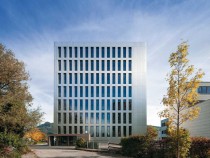
© Cree GmbH
With a height of 26 metres and a shimmering aluminium facade, the Lifecycle Tower in Dornbirn does not have the typical appearance of a wooden structure. This eight-storey timber hybrid building is the prototype of a form of construction created in interdisciplinary research work. The modular system can be employed for developments up to 20 storeys in height and consists of prefabricated facade elements and composite intermediate floors, complemented by an insitu concrete staircase core with a bracing function. The use of materials is optimized by the hybrid form of construction of the new composite ribbed floors in timber and concrete. The 2.70 x 8.10 m elements consist of an 8 cm compression topping layer in reinforced concrete (which also serves the needs of sound insulation and fire protection) and 24 x 28 cm laminated timber downstand beams. Synergetic concepts are also exploited in the facade elements, which (apart from the aluminium cladding) were prefabricated complete with glazing and columns, thereby considerably reducing the assembly time. All columns have a uniform 24 x 24 cm cross-section and occur in pairs at the junctions between modules in the facade plane, each one bearing a floor element. The modules are connected by steel pins at the heads of the columns, and the joints were ultimately filled with concrete. The floor elements function as bracing slabs that form non-combustible layers separating the individual storeys.





